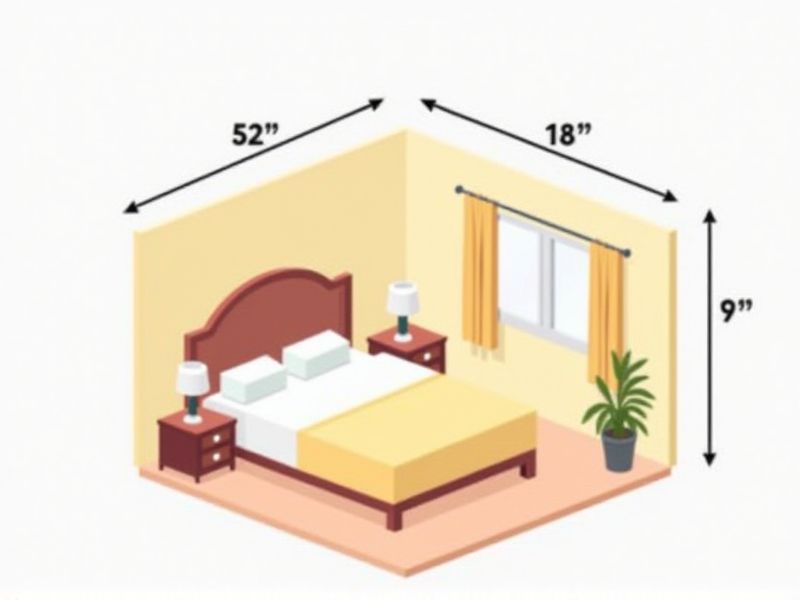
The standard dimensions of a typical hotel room range from 300 to 400 square feet (about 28 to 37 square meters), accommodating either a single king bed or two queen beds. This size provides enough space for essential furniture such as a bed, desk, dresser, and a small seating area, ensuring guests experience both comfort and functionality during their stay. If you're booking a room or planning a hotel, knowing these average dimensions can help set expectations for space and layout. It's also helpful to check directly with the hotel, as size can vary based on location, class, and brand.
Room Size In Square Feet
A typical standard hotel room ranges from 300 to 400 square feet, providing ample space for both relaxation and functionality. This size often accommodates a queen or king-sized bed, a desk, and essential furnishings for comfort. In many hotels, the layout includes a private bathroom, ensuring convenience for guests. When selecting your accommodations, be sure to consider not just the room size but also available amenities that enhance your stay.
Bed Type And Dimensions
A standard hotel room typically features a bed size categorized as either a queen or king, with dimensions of approximately 60 inches by 80 inches for a queen and 76 inches by 80 inches for a king bed. In many establishments, you may also find double beds, each measuring 54 inches by 75 inches, which are ideal for smaller accommodations. The choice of bed type can significantly impact your comfort level during your stay, especially considering factors like space and sleeping arrangements. Understanding bed sizes can enhance your overall experience, ensuring that your preferences for sleep quality are met in your chosen hotel room.
Ceiling Height
A standard hotel room typically features a ceiling height ranging from 8 to 10 feet, providing an open and airy atmosphere. Higher ceilings can contribute to improved acoustics, which enhances your overall comfort during your stay. Many hotels invest in design elements such as crown molding or decorative lighting to further accentuate this height. Consider how a well-designed ceiling can impact your perception of space, creating a more inviting and luxurious experience.
Closet Or Storage Space
A standard hotel room typically features a closet or storage space that measures approximately 5 to 6 feet in height and 3 feet in width, providing enough room for hanging clothes and storing luggage. Many hotels include shelving and additional drawers, offering an average of 20 to 30 cubic feet of storage for your belongings. You may find conveniences such as a luggage rack and hangers, ensuring easy access to your essentials during your stay. The design prioritizes functionality while maintaining a tidy appearance, allowing for a comfortable and organized environment.
Window Size And Type
A standard hotel room typically features a window size that ranges from 24 to 36 inches in width and 36 to 60 inches in height, allowing for ample natural light. Most windows are either single-hung or sliding types, providing ease of operation and ventilation. You may find options like double-glazed windows for enhanced insulation and noise reduction in higher-end accommodations. This design not only enhances your overall experience but also contributes to energy efficiency, with many hotels striving for a balance between aesthetics and functionality.
Bathroom Size And Fixtures
In a standard hotel room, the bathroom typically spans around 40 to 60 square feet, providing ample space for essential fixtures. Most bathrooms are equipped with a shower, tub combo or a standalone shower, featuring modern rain showerheads and tempered glass doors for a sleek appearance. You can expect amenities such as a toilet, a sink with counter space, and high-quality toiletries, often made from eco-friendly materials. Lighting options usually include both overhead and task lighting, enhancing comfort and functionality while ensuring a pleasant environment for guests.
Door Width And Accessibility
The standard hotel room door width is typically 32 inches, ensuring accessibility for guests with mobility aids such as wheelchairs. Compliance with the Americans with Disabilities Act (ADA) standards mandates that doorways provide sufficient clearance to facilitate easy entry and exit for all guests. Moreover, accessible rooms must include features like low thresholds and easy-to-operate door hardware, enhancing the overall user experience. When booking, you can ensure your comfort by confirming these features with the hotel to meet your accessibility needs.
Furniture Layout And Space
A standard hotel room typically features a layout that maximizes space efficiency, often spanning 300 to 400 square feet. The furniture arrangement usually includes a queen or king-size bed, a bedside table, and a work desk with a chair, allowing for both comfort and functionality. The room may also incorporate a compact lounge area, with a small sofa or armchair positioned strategically to create an inviting atmosphere. Essential amenities, such as a flat-screen television and a minibar, are seamlessly integrated into the design, enhancing your overall experience while maintaining a clean and organized environment.
Lighting Fixtures
The standard hotel room typically features a variety of lighting fixtures designed to enhance comfort and functionality, including table lamps, overhead lighting, and task lighting. Energy-efficient LED bulbs are commonly used, providing approximately 80% energy savings compared to traditional incandescent bulbs. Rooms often incorporate dimmable options, allowing guests to adjust brightness to their preference, which can significantly improve the ambiance during evening hours. Effective lighting design not only improves the aesthetic appeal of the room but also ensures that your activities, such as reading or working, are seamlessly supported.
Hvac System Placement
In a standard hotel room, the HVAC system is typically positioned discreetly to maximize guest comfort and aesthetic appeal. Common placements include wall-mounted units, positioned near entryways or windows, to enhance air circulation while minimizing noise disturbance. Proper installation allows for efficient temperature control, with average units operating between 14,000 to 18,000 BTUs to accommodate spaces of about 300 square feet. Ensuring effective HVAC placement can significantly improve your guests' overall experience by maintaining optimal indoor air quality and comfort levels.
